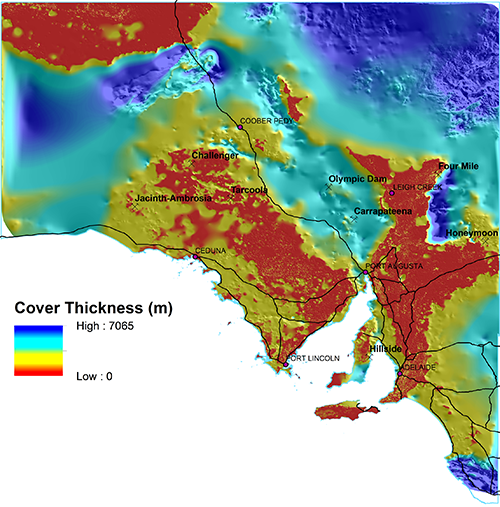Includes new datasets derived from the Gawler Craton Airborne Survey (GCAS).
Cover thickness is a fundamental consideration for mineral exploration in South Australia as roughly 75% of the state’s prospective basement rocks are hidden under younger sediments. As part of its precompetitive data, the Geological Survey of South Australia (GSSA) continues to release updates to the Depth to crystalline basement data package – a collection of GIS datasets that portray actual or inferred depth to crystalline basement.
Figure 1 South Australia cover thickness.
The 2021 package expands on previous releases to include over 500 additional stratigraphic drillholes and a new drillhole lithology logs dataset. An additional product – depth estimates calculated from magnetic field inversions – has been derived from processing GCAS magnetic data.
Local anomalies were selected to provide estimates of depth to the top of the source magnetisation that were considered likely to be generated from magnetisations arising at or near the basement–cover unconformity. Combined with magnetic source depth estimates from the Coompana Province and Murray Basin regions, the GSSA believe this data to be the largest set of individually modelled magnetic source depth estimates in the world.
The 2021 data package includes:
- crystalline basement stratigraphy drillholes
- crystalline basement lithology drillholes
- outcropping crystalline basement geology
- seismic interpreted basement
- airborne electromagnetic interpreted basement
- South Australia cover thickness grid
- cover thickness reliability map
- drillhole top of time slices
- magnetic source depths estimates
- magnetic source elevation grid
- magnetic source cover thickness grid.
The Depth to crystalline basement data package can be downloaded directly from the ‘New geoscience releases’ section of the department website or via the South Australian Resources Information Gateway (SARIG).
GCAS datasets can be downloaded directly from the GCAS webpage on the department website or via SARIG.
For assistance with downloading datasets contact DEM.CustomerServices@sa.gov.au
– George Gouthas, April 2021



